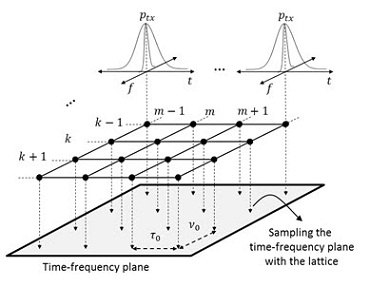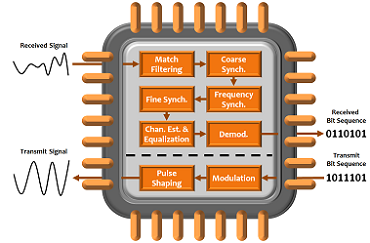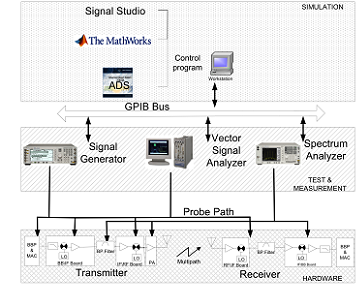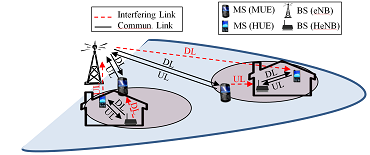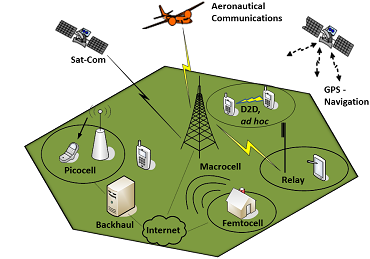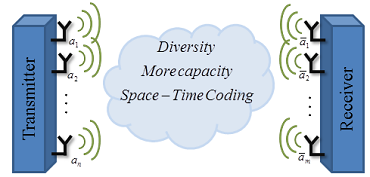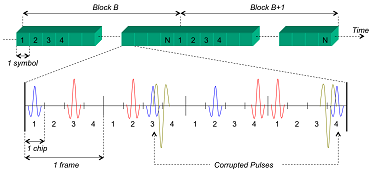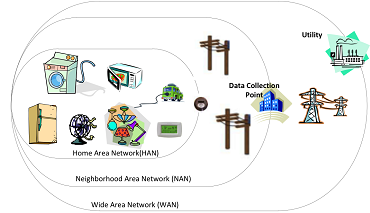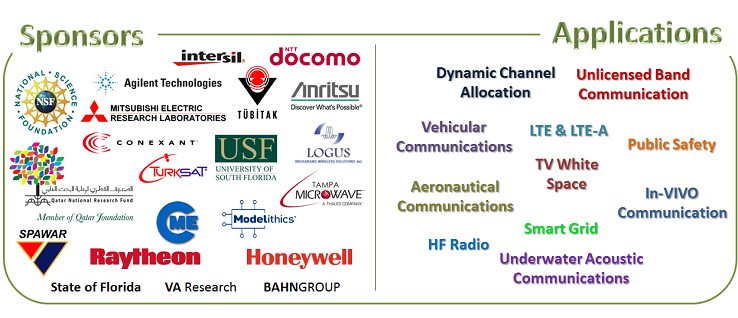
Research Activities
Some of the specific research projects can be summarized as:
- Spectrum sensing/estimation and interference awareness
- Spectrum shaping (waveform shaping)
- Signal characterization (classification and identification of signals)
- Radio channel parameters estimation
- Cross-layer adaptation and optimization
- Exploiting OFDM(A) and UWB for Cognitive radio
- Geo-locationing and use of it for improved communication
- Signal intelligence (SigINT) - multi-dimensional signal analysis
- Testing, measurements, and certification of wireless products, signals and systems
- Carrier aggregation in cognitive radio and other broadband communication systems
- Channel measurements and modeling in irregular environments
- Smart homes and advanced metering
- Waveform/Modulation design beyond OFDMA (5G and beyond)
- Equalization, synchronization, channel estimation, and interference cancellation for next generation wireless systems
- Radio and channel parameters estimation for advanced and adaptive transceiver design
- HF, VHF, and UHF digital baseband radio design
- Impact of wind turbines on wireless signals
- Multi-dimensional cognitive networking
- Quasi orthogonal multiple accessing (Partial overlapping in multi-dimension)
- Modeling radio front end impairments (like PA nonlinearities, IQ impairments, phase noise etc.)
- compensation of their effects using advanced digital baseband algorithms.
Advanced Waveform Design | Baseband DSP Algorithm Development | Cognitive Radio and SDR
Testing & measurements | Interference | Heterogenous Networks | MIMO | UWB | PLC and Smart Grid
Major Application Areas of Our Research
Advanced Waveform Design
Efficient management of multi-dimensional resources has gained new aspects as inevitable results of overlapping
and coexistence of many communication systems. New waveforms approaches exploiting the complementary features
of multi-dimensional resources emerge to be a tempting solution to break the bottleneck in the physical layer
toward heterogeneous networks. In this context, novel waveform designs to fulfill the requirements of
heterogeneous networks constitute our main research interests. Toward this ultimate point, our scope ranges
from the fundamental properties of the waveforms (e.g., pulse shapes, orthogonality, nonorthogonality,
time-frequency lattice) to the frame structures in the transmission. We investigate not only waveform itself
in time-frequency in terms of channel adaptation and flexibility, but also cross relations between waveforms
like signal separability regarding to the their suitability to next generation networks. Additionally,
considering practical systems, we focus on their impacts on the other topics in physical layer (e.g. PAPR,
equalization, channel estimation, out-of-band radiation) and MAC layer (e.g. scheduling), since they
essentially affect the transmitter and receiver algorithms.

Related last projects can be found here.
Current Efforts
- Non-orthogonal/Orthogonal/Biorthogonal multicarrier systems
- Time-frequency characteristics of waveforms, Gabor systems
- User-based and heterogeneous network-bearing waveforms
- Spectral shaping for OFDM-based waveforms
- Separability of waveforms
- Covert OFDM communication (Physical and MAC layer security enhancement techniques)
Digital baseband signal processing algorithm development for future wireless communication systems
Advanced digital baseband algorithm designs can improve the performance of the communication system, reduce the
computational complexity and power consumption, extend the range of communication, and increase the data rates.
Actually, the enabling factors for current developments and future projections in wireless communications are
the flexibility and capability in digital signal processing (DSP). In other words, the requirement for the
efficient design can vary depending on the application and type of the network. as well as the requirements
can change in time for a given application or network depending on the user context and channel conditions.
Therefore, adaptive, channel aware, and user aware algorithm designs are critical for the next generation systems
that will mostly be possible with digital baseband processing advances.
Current Efforts
- Channel estimation, tracking and equalization
- Time, frequency, and phase synchronization
- Soft information generation
- Detection and estimation of various channel, signal, and user parameters
- Interference cancellation and multi-user detection
- Blind receiver algorithm designs (Blind synchronization, channel estimation, equalization)
- Blind modulation order and type detection
- Blind signal identification
Cognitive Radio and Software Defined Radio
Demands for more bandwidth requiring applications and increasing number of wireless devices caused
inevitable evolution of wireless systems. However, the spectrum is still limited and spectral crowd
pushes more efficient spectrum usage. This brought the idea of cognitive radio (CR) which has spectrum
sensing, awareness of its surroundings, learning and self-adapting capabilities to maintain communication
in an opportunistic manner. Development of such systems is encouraged by regulatory agencies such as
Federal Communications Commission (FCC) in United States, to have licensed spectrum become available
to the unlicensed/secondary users to increase spectral efficiency. As WCSP Group, we are interested in
developing CR and software defined radio (SDR) algorithms to enable future radios to have advanced
capabilities and designing CR test beds in our well equipped laboratory to test performance of the
proposed techniques in practical cases.
Related links can be found here.
Current Efforts
- Dynamic spectrum access
- Spectrum sensing and spectrum shaping
- Signal intelligence (SigINT) and identification
- Channel awareness and real-time channel parameters estimation
- User awareness and user context estimation
- Mobility modeling and estimation
- Adaptive waveform and signal design
- Cognitive radio measurements and metrics design
Testing, measurements, and modeling
Testing, measuring, and verification of next generation wireless devices, sub-systems, and
networks are very challenging. The challenge is not only in hardware (requiring wideband signal
analysis and generation capabilities as well as high speed ADC/DAC and fast processing
capabilities), but also in software (requiring additional test vectors, performance metrics,
user interface, etc.). The next generation tools should have the ability to process wide
variety of waveforms and should be equipped with autonomous synchronization and detection
capabilities. In addition, understanding the transient behaviors of the transmitted and received
signals is crucial. We are interested in testing, measuring, and modeling the components, devices,
wireless channel, RF front-end subsystem, interference, network of radios, etc.
Related last projects can be found here.
Current Efforts
- Measurement and modeling large and small scale characteristics of communications channels
- RF front-end and its impact in the overall system in terms of temporal characteristics (like PARR, CCDF), spectral characteristics (like ACPR, out-of band interference, IMP), in-band interference, BER, etc.
- Interference modeling and measurements
- Spectrum usage measurements and modeling
- Cognitive radio measurements and modeling
Interference
Interference is a limiting factor for the capacity of wireless services and might occur as a
result of loose planning of wireless networks, mobile device hardware impairments and impacts
of wireless channel. Accordingly, increasing demand for more bandwidth consuming applications
and lack of spectrum availability with the introduction of heterogeneous network (HetNet) nodes
leads to denser frequency reuse and coexistence of different technologies. This leads future
wireless networks to observe interference from even a larger number of sources. As WCSP Group,
we believe that interference is a significantly important issue for both commercial and
public safety communication systems. Therefore, first we focus on understanding and modeling
the interference scenario to exploit unique characteristics for interference suppression,
and accordingly develop novel techniques based on the most suitable interference avoidance,
coordination or cancellation approaches considering the available resources, e.g. processing
power. In this context, we analyze the impact of interference in multiple domains such as
time, frequency, and space and make use of the results to propose multiple-domain
linear/non-linear (iterative) cancellation or coordination techniques.
Related last projects can be found here.
Current Efforts
- Interference Cancellation and Multi-User Detection
- Interference Identification
- Interference Coordination and Management
- Interference Measurements and Metrics
- Intentional interference and partial overlapping waveform design
Heterogeneous Network
With the urge to be always-connected to network along with data-hungry applications traditional
homogeneous large scale network deployments are not sufficient to address emerging throughput
demands of broadband wireless users. Especially, the new applications (e.g. real-time video caller,
HD movie player), which can dictate for symmetrical or asymmetrical traffic, require flexible
networks with high speed connections. Satisfaction of these recent trends constitutes the main
driving force for heterogeneous networks that allow various types of cells at different scales
(e.g. femtocells, picocells) to operate at the same spectrum for increased reuse and provide
more freedom for the network connections. Recently, significant effort has been devoted to
maximize the spectral efficiency and network flexibility for heterogeneous deployments.
However, interference between cells utilizing the same spectrum resources still constitutes
the main problem of heterogeneous networks. As WCSP group we are focused on PHY/MAC layer
algorithms for next generation network deployments including theoretical analysis and
optimization of the systems. Our current research areas include but not limited to load
balancing, mobility and interference management in heterogeneous networks.
Current Efforts
- Multi-tier networks
- Enhanced small cell deployments(Indoor/Outdoor)
- Device-to-device (D2D) Communication
- Load balancing solutions
- Mobility issues
Multiple-input multiple output (MIMO) Systems
Research goal is to study and improve multiple-antenna transmission and
multiple-antenna reception (MIMO) wireless communication systems. Issues
related to mutual coupling and correlation between antenna elements,
multi-user receiver algorithms for MIMO schemes, channel estimation and
tracking of multi-channel, synchronization, and frequency offset estimation
are among the focus areas. More specifically, our focus is the application of
MIMO to OFDM systems (MIMO-OFDM). Currently, the OFDM based wireless test-bed
is being updated to test and develop MIMO-OFDM research.
Previously completed works
- Dynamics of Spatial Correlation and Implications on MIMO Systems
- Study of mutual coupling effect in MIMO and multi-antenna systems
- MIMO channel estimation
- MIMO systems performance measurements under realistic interference, noise and impairment conditions
- MIMO-OFDM synchronization and frequency offset estimation
- Single Receiver MIMO-OFDM Signal Measurements
- Signal Direction Estimation and MIMO Systems
- Capacity and System Performance Evaluation for MIMO Systems
UWB Communications
Development of new physical layer techniques for the improvement of
ultrawideband (UWB) systems for personal area wireless communication systems.
Algorithms that increase data rate, improves capacity and system performance,
reduce the power consumption by designing simple and power efficient algorithms
are some of the goals. Research includes multi-user interference cancellation,
narrowband interference cancellation, multiple access techniques and multiple
access code design, study and evaluation of modulation options, ultrawideband
channel characterization and study of its effect on the system, jitter and
multipath analysis, receiver enhancement algorithms including improved channel
estimation, practical and efficient Rake receiver design, interference
cancellation receiver algorithms etc.
Previously completed works
- UWB Modulation Types
- Timing Jitter effect on UWB Systems
- UWB Rake receiver design
- Multipath Robust PN Code Design in TH-UWB Systems
- Synchronization and channel estimation in Impulse radio based UWB systems
- OFDM based UWB design
Power line Communications and Smart Grid
In spite of being attractive, PLC channels are very harsh, posing great
challenges to the performance of communication systems. Similar to wireless
communication channels, when a signal is transmitted on the power line conductors,
the received signal consists of attenuated, delayed, and phase–shifted replicas
of the transmitted signal causing multipath, fading, and delay spread. Time
selectivity in PLC channels is mainly caused by the variation of the impedance
conditions in the network especially at the termination points. The noise and
interference conditions in PLC channels are relatively more complex than that
of wireless channels. As a result, there are so many research challenges and
opportunities in power line communication.
Previously completed works
- Powerline channel modeling
- OFDM and multicarrier waveforms for powerline communication
- Narrowband interference and impulsive interference cancellation
- Robust and efficient digital baseband algorithm design
Major Application Areas of Our Research
- LTE and LTE-advanced (i.e. small cells, interference coordination and cancellation, CoMP, femtocells, adaptive PHY and MAC design, higher order modulations)
- Smart Grid (i.e. secure and reliable communication design, application of PLC and wireless to smart grid,
- TV-White Space (i.e. spectrum sensing, waveform shaping for efficient utilization of spectrum opportunities, spectrum hand-off )
- Dynamic channel allocation (i.e. spectrum sensing, efficient modulation and waveform design, spectral shaping, interference management and avoidance)
- Reliable Communication in Unlicensed Bands (i.e. Interference avoidance and cancellation, dynamic spectrum utilization)
- Public safety and military radio (i.e. secure link design in PHY and MAC layers, SigINT, communication in harsh channel conditions, software defined radio, cognitive radio)
- Aeronautical communications, High Altitude Platforms (HAP) (i.e. handling Doppler spread and mobility issues, exploiting the channel for efficient radio and network design)
- High data rate underwater acoustic communications (i.e channel modeling, application of OFDM to underwater communication, interference cancellation and avoidance)
- HF radio (i.e. HF channel modeling and efficient digital baseband algorithm design, equalization, channel estimation and tracking)
- In-vivo communication (i.e. in-vivo channel modeling, efficient link and network design for in-vivo channels)
- Vehicular communications, V2V, V2I (i.e. mobility issues, mobility modeling, Doppler handling, adaptive PHY and MAC design, radio parameters estimation and tracking)
